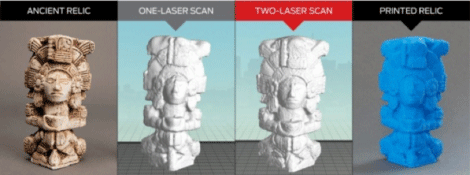
MakerBot, has kept us on tenterhooks with the release of their newest desktop contraption, the MakerBot Digitizer.
MakerBot is quickly becoming a synonym for 3D printing in the public eye thanks to its unrelenting media, faire and convention appearances, impressive customer references list (“by appointment to NASA” is certainly worthy of a bumper sticker) and above all else, its push for quality on the miniature scale.
What better complement then to it’s assortment of affordable desktop printers than your own desktop laser scanner, for a base price of $1,400.
After the idea was pitched earlier this year, we’ve had little to speculate on what the device would look like, how it would work and how much it would cost.
From June onwards however, we began to see some interesting developments from their blog.
The design of the scanner looks like an Amstrad Turntable, which in comparison to MakerBot’s previous ply and cable incarnations, is a definite improvement.
In keeping with the style of the Replicator2 and 2X, this matte black professional style is hopefully (for those who value a certain ‘look’ to their workspace) the beginnings of an aesthetic trend, similar to Apple and brushed aluminium or Cath Kidson and ‘God awful’.
From what we can glean from MakerBot’s Blog, the specs for this scanner promise a reliable and quality product.
Boasting two lasers and a camera, MakerBot claims the device can scan and produce “high-quality, water-tight 3D models, in as little as three minutes.” This claim can be backed up for three very good reasons.

First, the use of a two laser system over just one should enhance the accuracy and resolution of the scan.
Secondly, the scanned model can be automatically flattened at its top and base. “The Digitizer’s software automatically finds the bottom of the object and creates a closed flat surface.
This is important because 3D models that aren’t completely watertight, or “manifold” in technical terms, can cause major problems for 3D printing algorithms. Making a model watertight can be labour intensive, so we automated the process.”
Finally, the software is intuitive enough to take over the repair process when the raw scan data resembles a block of Swiss cheese.
This feature should enable those with no understanding of NURBS or points or meshes to still successfully scan an object and have it printed.
What’s more, this is a fantastic example of how MakerBot is streamlining the technology enough for average Joe to pick up a printer or scanner and start creating (for a price of course), thus not only pushing this technology further down the mass consumer route, but also cornering the market as it goes.
As for the scan size, it’s easy to see from the press release image that you’re not going to be scanning yourself a new set of dining room chairs any time soon, but a new set of teacups seems pretty realistic.
Its own press release states: “When we announced the MakerBot Digitizer Desktop 3D Scanner, we asked people what they would scan. Art and artefacts were at the top of the list.”
Users are going to be varied, so we’ll have to wait and see if the newest addition to the MakerBot family can keep up with expectations.






